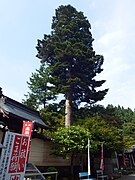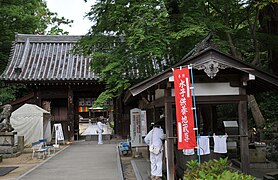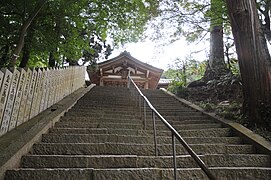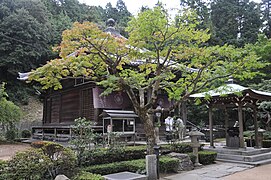Shiromine-ji
The Shiromine-ji ( Japanese 白 峯 寺 ) with the Go Ryūshōzan (綾 松山) and Dōrinin (洞 林 院), halfway up Mount Shiromine in the city of Sakaide ( Kagawa Prefecture ), is a temple of the Shingon direction of Buddhism . In the traditional count, it is the 81st temple on the Shikoku pilgrimage route .
history
According to tradition, to priests Kūkai have come in 815 to diesenm place and a source of desire Jewels have dug. His student Enchin (円 珍; 814–881) is said to have carved a thousand-armed Kannon from the wood of a sacred tree (霊 木, Reiboku) , which became a cult object.
When emperor Sutoku (崇 徳) had to flee during the Hōgen rebellion in 1164 , he came to the province of Sanuki , where he settled and later died. A tomb and a place of worship, the Tonshō-ji (頓 證 寺) temple, were built for him. It was later moved to its current location and renamed Toshō-jiin (頓 證 寺院).
The attachment
Already down in the valley you pass the first gate (一 の 門, Ichi no mon), further up you pass two 13-story stone pagodas. They are about 2 m high and, according to the inscription, date from 1278 and 1324 and are registered as a national treasure. Then you enter the spacious temple complex through the actual temple gate (山門, Sammon; 1). The current one dates from 1803 and is designed as a gate in the Kōrai style , here with an additional wing on each side. The large-scale monastery complex (本 坊, Hombō; K) extends on the right-hand side, and its guest area is accessible through its own gate on the right. There is also the tall Momi fir , marked in green on the plan. Opposite, on the left, is the tea house (茶 堂, Chadō; 2). Ahead you can see the Goma Hall (護 摩 堂; Gomadō; 3).
Then the path turns left. After 40 m, just before the magnificent “gate for the imperial envoy”, the Chokugakumon (勅 額 門; 11; national treasure), on the right is the Mizuko-Jizō (水 子 地 蔵), protected by a roof, to which people pray after miscarriages. Immediately behind it, a long staircase begins on the right, which leads to the main hall (本 堂, Hondō; 9). On the way there follow the Yakushi Hall (薬 師 堂; 4), the Bell Hall (鐘楼堂; Shōrōdō; 5), the Gyōsha Hall (行者 堂; 6), the Ekōdō (廻向 堂; 7) and the Amida Hall (阿 弥陀 堂; 8). The hall commemorating the temple's founder, the Daishidō (大師 堂; 10), is set apart.
If you return to the stairs and turn to the right, you have that in front of you. Behind it you can see the Toshō-jiin (12). The buildings were restored in 1680 by the princes of the Takamatsu clan, Matsudaira Yorishige (松 平 頼 重) and Matsudaira Yoritsune (松 平 頼 常). The prayer hall (拝 殿) is covered with wooden shingles (檜 皮 葺). Tachibana lemons (橘, Tachibana) and cherry trees were planted in the front yard. The whole complex is supposed to be reminiscent of the Imperial Palace in Kyoto, which had to be abandoned.
A little outside is the Shiromine Goryū (白 峯 御 陵; 23), the grave of the emperor Sutoku, surrounded by a lattice.
photos
literature
- Kagawa-ken no rekishisampo henshu iinkai (Ed.): Shiromine-ji . In: Kagawa-ken no rekishi sampo. Yamakawa Shuppan, 2013. ISBN 978-4-634-24637-9 . Pages 117 to 120.
- Oguri, Doei: Kukai. Shikoku hachijuhachi kosho no arukikata. Chukei no Bunko, 2011. ISBN 978-4-8061-4067-2 .
Web links
← Previous Temple: Sanuki Kokubun-ji | Shiromine-ji | Next temple: Negoro-ji →
Coordinates: 34 ° 20 '0.7 " N , 133 ° 55' 36.4" E









